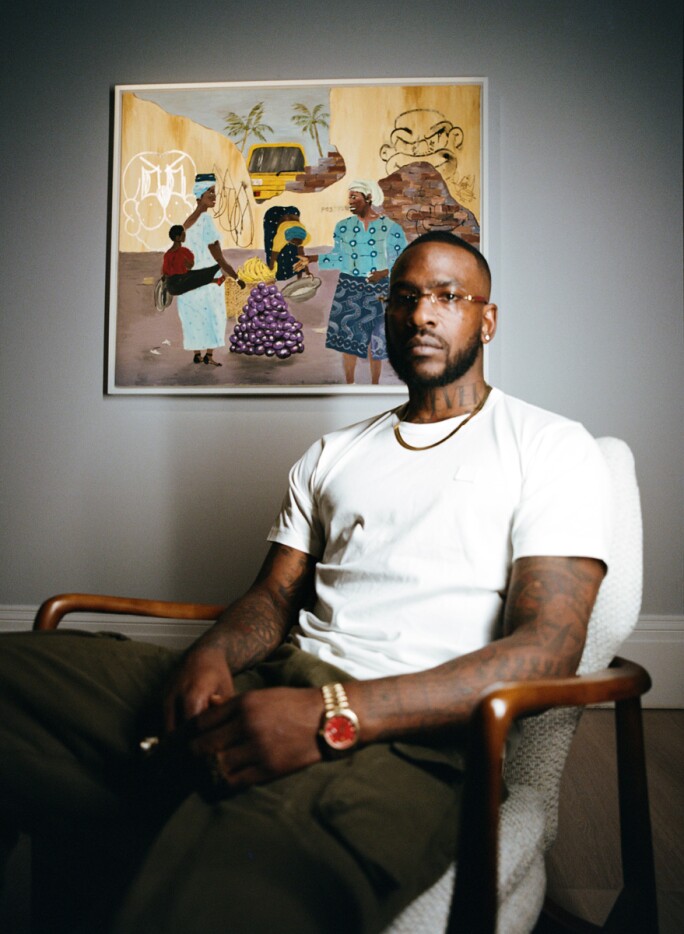J oseph Olaitan Adenuga Jr has always been interested in the many forms that art can take. Best known by his stage name, Skepta, the British Nigerian is one of the UK’s most prolific rappers and producers. He occasionally works in fashion too (collaborating with Nike and designing for his clothing line, Mains), so his first venture into painting comes as no surprise. “I live and breathe art in everything I do, everything I think,” he says. “When I look at something I analyse it and lose myself in it – I’ve always been into loads of different styles of creation.”
During the 2020 lockdowns he says he was “in the house pulling the last hairs out of my head”. The worry that the pandemic might mean he would not be able to take River, his daughter, over to Lagos to see her relatives became the inspiration for his first painting, Mama Goes to Market. This work will be included in a landmark collaboration with Sotheby’s, which will see him select works for its Contemporary Curated sale in September.
“I was just dealing with that thought and frustration,” he says about the process of creating the painting. “Will River get to go to an African market, or see her mum go to one? I thought ‘she will always have to buy everything online, she’s never going to experience this’ – so I tried to portray it in paint.”
Initially, he didn’t take it seriously, finding the process so slow compared with making music that he assumed he would never finish it. But the result is striking: Mama Goes to Market is both colourful and tender, with figures that evoke the soft theatricality of works by Lubaina Himid.
“For me it’s about that beautiful thing of being able to look at a picture and feeling an emotion. If I look at an art piece and feel something, I fall in love with it”
Although the painting looked 'done', Skepta felt something was missing: the walls of a Lagos marketplace would never be blank. He heard that the graphic artist Chito was doing a pop-up with the fashion brand Givenchy, so rather than bringing clothing for Chito to customise, Skepta decided to take his painting. Now the wall is decorated with distinctive licks of graffiti by Chito that he drew with a Sharpie – Skepta then went over them with a stencil and spray paint.

He also enlisted Nigerian artist Slawn and his fellow UK music pioneer Goldie to add to it. He admires how these artists take up space with their work. “That’s how I live,” he explains. “We’re not given anything, we have to barge our way into places when it comes to this industry, so that kind of mindset is fire to me.”
For the Contemporary Curated sale, Skepta has selected Mama Goes to Market alongside spray-painted pieces by Chito and Slawn, as well as a surreal portrait by Lynette Yiadom-Boakye, collage work by Ouattara Watts and a densely textured Abstract Expressionist painting by Frank Bowling.
There is no single thread that ties the pieces together. “‘Good’ and ‘bad’ art is always gonna be subjective,” he says. “But for me it’s about that beautiful thing of being able to look at a picture and feeling an emotion. If I look at an art piece and feel something, I fall in love with it – I’m interested in how and what it’s making me feel.” He nods to his deep love of Edvard Munch’s The Scream, as well as the artwork for albums by Tupac Shakur, Pink Floyd and Queen, stressing that young people should find artworks that resonate with them rather than worrying about what they think they should like.

Skepta often uses his work as a way to talk about where he is from, not least as a means of self-reflection. “My job is to fight for this identity to stay,” he says. “Anyone who was born in a country that isn’t your maternal home... I think it would serve you well to delve into your culture.”

Though he is still in disbelief that this moment with Sotheby’s is happening, he is not especially interested in returning to fine art. “Only if there was another lockdown,” he laughs. “Right now I can’t wait to make more music – that’s what I’m thinking about.”
Skepta’s main takeaway from his foray into painting is a respect for this slower approach to creating, and a desire to support others trying to make their way in the art world or simply thinking about giving art a try.
“I have gained a massive appreciation of the emotion, energy and creativity of artists, many of whom sit for hours at a time,” he says. “I want artists to speak to me, I want to lift them up and have others appreciate them as I do. I want, hopefully, to be able to get them the support I have had.”
Photography by Dexter Navy





